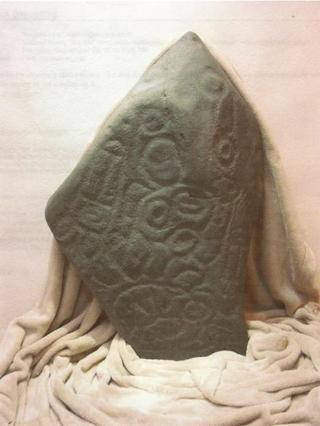Aleutian Rock Art Rediscovered

Thursday, December 08 2011
A stone that was used as a garden ornament for the last fifty years may turn out to be one of the most important archaeological finds in Aleutian history, offering new insights into Unangan culture.
The stone is two and half feet wide by three feet tall and weighs more than 250 pounds. Lifting it requires a forklift.
But the elaborate etchings that cover one entire side are delicate. Centuries, if not millennia, of erosion have smoothed any sharp edges, leaving a maze of ridges and valleys.
The symbols are hard to interpret. Even the woman who owned the stone for more than fifty years says she can’t pick out much more than the fact that the outline looks like a seal.
“At first it looked like a fish, but because of the nostrils, we decided that it was a seal. But there were other carvings on the back of it that just seemed to be random designs, not related to being a seal.”
That’s Betsy Burr. She and her mother purchased the stone at an antique store in Berkeley, California sometime in the late 50s or early 60s. All she knew about it until recently was the story the antique dealer told them, which was that an airman stationed in the Aleutians during World War II had found it on a beach and shipped it south on a cargo plane.
“He intended to sell it and make a lot of money for it, because he thought it must be very valuable, but his time was up and he couldn’t find a buyer.”
Burr’s mother purchased it for 25 dollars and installed it in their garden. The stone moved around with the family up until 2001, when Burr’s father passed away and Burr inherited the stone. She now lives in New Jersey and she didn’t want to have the stone shipped from California, so she gave it to her brother-in-law, who put it in storage for almost a decade.
Then, in 2009, she decided it was time to sell it. Like the airman, she was hoping the stone would be valuable.
“It was a big surprise to find that the rock didn’t belong to us, because we did think that it belonged to us. We didn’t know it belonged to the federal government.”
It turns out that if the antique dealer’s story is true, the stone probably does belong to the government.
The airman was likely stationed on Shemya Island, which was used as an Air Force base during World War II. That means anything taken from the island during that period also belongs to the government.
So Burr gave the stone to the Museum of the North in Fairbanks. Researchers there are trying to independently verify its origins by comparing its composition to rocks on Shemya.
But no other rock art has ever been reported on Shemya. In fact, petroglyphs have only been found once before in the Aleutians, on Agattu Island, about 30 miles to the southwest. Archaeologist Allison McLain says that makes figuring out where the stone came from more urgent.
“It could change our interpretations of Aleut art, it introduces us to a form of Aleut art that we didn’t really know existed until now. Other than the petroglyphs on Agattu. Which are radically different in some ways from the art that’s carved into the seal stone.”
McLain was contracted by the Museum to do an analysis of the stone’s inscriptions. She says the symbols Burr had trouble interpreting are what make the stone interesting.
“It’s not free and clear. If you go to Kodiak and look at the petroglyphs, it’s very clear. There’s a face, there’s a canoe, there’s a whale. It’s not the case with the seal stone, which is part of why I think it’s so fascinating.”
McLain says she can pick out a seal, birds, a whale, several human faces, a phallus, female genitalia, and potentially a sea monster. She’s trying to match the petroglyphs to other Unungan art to figure out when and where the stone was carved.
She’s also holding out hope that someone will come forward with more information.
“Sooner or later someone will remember ‘oh yeah, this is what I did with that artifact after I took it off this Aleutian Island I was stationed on during World War II.’”
If the stone does end up being from the Aleutians, McLain sees it as a promising sign that there might be more petroglyphs out there, waiting to be found.




Simon - Australia on Saturday, June 09 2012:
Fantastic Story. cant wait for more cold mysteries from the othe side of the world. GREAT WORK EVERYONE!